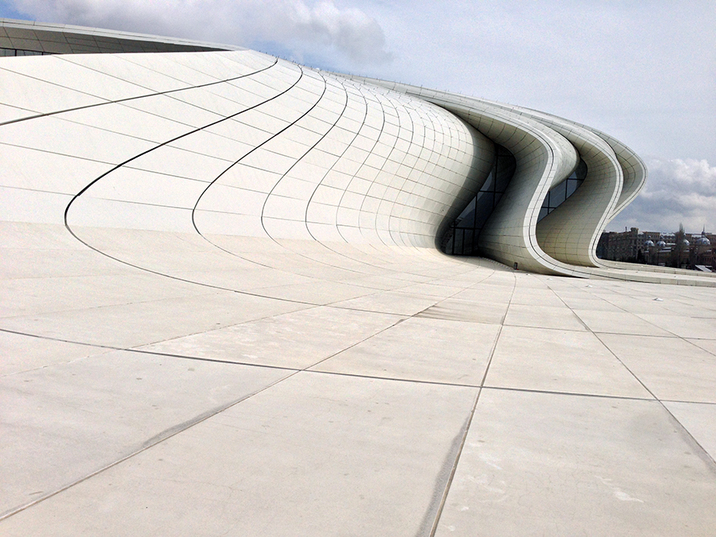
R
E
V N
E
X
T
The pioneering Pritzker Prize-winning architect ZAHA HADID, who passed away unexpectedly on March 31, 2016, at the age of 65. Photo sourced from designboom.com.
Zaha Hadid died early Thursday morning, on March 31, after suffering from a heart attack while at a hospital in Miami. The renowned architect’s sudden death at age 65 falls heavily on the architectural world and all who have come into contact with her unique buildings across the globe.
Frequently hailed as one of the most visionary architects of the late 20th and 21st centuries, Hadid garnered an impressive litany of achievements in her lifetime: she was the first woman to receive the Pritzker Prize for Architecture in 2004; twice won the Stirling Prize—the most prestigious architecture award in the United Kingdom presented by the Royal Institute of British Architects (RIBA)—for 2010 and 2011; and was also the first woman to receive RIBA’s Royal Gold Medal in 2015. In 2012, she was named a Dame Commander of the Order of the British Empire in recognition of her pioneering design work and service to architecture.
Max Protetch, Hadid’s long-time art dealer, told ArtAsiaPacific by phone, “She was the most original voice in architecture when I decided to show her 30 years ago. One thing that struck me, [and continues to] even now, was how she was constantly misunderstood. She was a diva that was a joy to work with. Most people didn’t understand her work. It was not just random abstraction; rather, she was reacting to [each] program and location site, and all of her architectural forms originated from this. She was an incredible force in architecture.”
Beyond her numerous awards, the story of Hadid’s life and career is one of struggle and resilience, having overcome the restrictions and limitations imposed on women in what was and still is, largely a male-dominated industry. Born and raised in Iraq, Hadid studied mathematics at the American University of Beirut before moving to London and enrolling in the Architectural Association in 1972, where she later taught alongside architects such as Rem Koolhaas and Daniel Libeskind. Following her graduation from the Architectural Association in 1977, Hadid spent a short time working in the Office for Metropolitan Architecture (OMA), Koolhaas and Elia Zenghelis’s newly established firm. With her steadfast vision, she went on to develop her own practice, one that would nurture her unique style. In 1979, Hadid established Zaha Hadid Architects, which, with a staff of more than 400 in 44 countries, has conceived more than 950 projects to date.
For decades, Hadid used painting and drawing to explore her futuristic concepts, which were inspired by Russian Constructivists such as Kazimir Malevich. Many of these were presented in a 2006 solo exhibition of her work held at the Solomon R. Guggenheim Museum in New York. Discussing her process in a 2011 interview, Hadid explained how she would paint and draw her plans, tracing over layers of paper “like a form of reverse archaeology,” where anomalies in the sketch would lead to distortions in their built forms. Later technology would render her avant-garde ideas possible, allowing her to develop such epic plans as the Peak Leisure Club in Hong Kong between 1982 and 1983. Though the project was never realized, the drawings for the club paved the way for an oeuvre characterized by a love for cosmic arcs and never-ending curves that, as colleague and Hong Kong Institute of Architects president Vincent Ng stated, “few believed. . . could be transformed into reality.”
A pivotal point in Hadid’s career, which spanned continents and decades, was her 1993 deconstructivist design for the Vitra Fire Station in Weil am Rhein, Germany. The sharp lines of the building and considerations of interior space propelled Hadid’s practice, launching her into architectural stardom. As her visual language evolved throughout the course of her career, Hadid remained resolute in realizing her dynamic architectural shapes, which ranged from the neo-futuristic—in projects such as Michigan State University’s Eli and Edythe Broad Art Museum (2012)—to the sensual contours seen in her London Aquatics Centre (2011) and Baku’s Heydar Aliyev Center (2013). In Hong Kong, Hadid’s distinct mark can be found in the Jockey Club Innovation Tower, built in 2014.
Though she took her practice seriously, Hadid also expressed the need for lightness in architecture. In another 2011 interview with Architectural Review she explained: “Architecture is for well-being; it should be enlightening and should make you feel good. I don’t think you are supposed to just go to a place to contemplate the end of the world. There is this idea that architecture has to be dour and heavy-handed.” The defiance of gravity in her fluid forms, the heterogeneous functions of her buildings and other designs in jewelry and furniture are a testament to this belief she held about architecture.
In a statement released on the day of her passing, Zaha Hadid Architects expressed sadness for the loss of their “larger than life, bold as brass, and certainly on the case” founder and heroine. While she leaves a large hole in the cultural world, her legacy lives on in her buildings, designs and her inspiring leadership as a pioneering woman in architecture.




